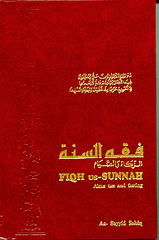Fiqh Assunah

Fiqh-us-Sunnah, Volume 2: Salatul Kasuf, prayer of the solar and lunareclipse
The scholars agree that the prayer of the eclipses is a sunnah mu'akkadah, astressed one, which is to be performed by both men and women. It is best topray it in congregation although the congregation is not a condition for it.The people are called to it by announcing as-salatu jami'ah "prayer incongregation." The majority of the scholars hold that it is to consist oftwo rak'at and that in every rak'ah one is to perform two bowings (ruku')instead of the customary one.
'Aishah narrates: "There was a solar eclipse during the time of theProphet sallallahu alehi wasallam and the Prophet went to the mosque, and hestood and made the takbir, and he put the people in rows behind him, and hemade a lengthy recital during the salah. Next, he made the takbir and made along ruku', but it was not as long as the recital. Following that, he raisedhis head, saying: 'Allah hears him who praises Him. And to You, our Lord,belongs the praise.' Afterward, he stood and made another long recital but itwas shorter than the first one. Again, he made the takbir and made a ruku' thatwas shorter than the first one. Then, again he said: 'Allah hears him whopraises Him. And to You, our Lord, belongs the praise.' After this, heprostrated. He did the same in the next rak'ah and finished four ruku' and foursujjud. The sun appeared again before he finished. Finally, he stood andaddressed the people and praised Allah as He deserves it and said: 'The sun andthe moon are two signs from among Allah's signs and there is no eclipse due tosomeone's death or life. If you see them occurring, hurry to pray.'" Thisis related by alBukhari and Muslim.
Bukhari and Muslim also record that Ibn 'Abbas said: "There was a solareclipse during the life time of the Prophet sallallahu alehi wasallam and heprayed with a long standing, similar to what it takes to recite alBaqarah.Then, he made a long ruku'. After which, he stood and made another long recitalbut shorter than the first one. Again he went into ruku', but for a shortertime than in the first one. Following this, he made sajdah [twice]. Next hemade another long standing (qiyam) which was also not as long as the first.After that, he made another lengthy ruku' but it was not as long as the firstone. Again, he made another long qiyam [and recital] but it was not as long asthe first one. After which, he made another lengthy ruku' but it was not aslong as the previous one. Following this, he went into sajdah [and so on]. Whenhe had finished, the sun had appeared. He concluded his prayer and said: 'Thesun and the moon are two signs from the signs of Allah, and there is no eclipsedue to the death or life of anyone. If you see it, make remembrance ofAllah.'" Grading these reports, Ibn Abdul Barr says: "These twohadith are the most authentic reports on this topic."
Ibn al-Qayyim observes: "The authentic, clear, and prepondering sunnahconcerning salatul kasuf is that the ruku' is to be repeated [twice] in everyrak'ah. This is based on the hadith from 'Aishah, Ibn 'Abbas, Jabir, Ubayy ibnKa'b, 'Abdullah ibn 'Amr ibn al-'Aas, and Abu Musa alAsh'ari. They all reportthat the Prophet repeated the ruku' in one rak'ah. Those who mention therepeating of the ruku' are more in number, weightier, and closer to the Prophetsallallahu alehi wasallam than those who do not mention it." This is theopinion of Malik, ash-Shaf'i, and Ahmad.
Abu Hanifah is of the opinion that salatul Kasuf consists of two rak'at,similar to salatul 'id and jumu'ah, based on the hadith of An-Nu'man ibn Bashirwho says: "The Messenger of Allah sallallahu alehi wasallam prayed thesalatul kasuf with us like one of your prayers. He went into ruku' andperformed sajdah, praying two rak'at by two rak'at, and supplicated to Allahuntil the sun reappeared clearly again."
In the hadith from Qabsah al-Hillali, the Prophet said: "If you seethat [i.e., an eclipse], pray as you pray the obligatory prayer." This isrelated by Ahmad and an-Nasa'i.
The reciting of al-Fatihah is obligatory in each rak'ah, and one may recitewhatever one wishes to, after Al-Fatihah. It is allowed to make the recitalaudible or silent, but al-Bukhari says: "Audible recital is more proper."
The prayer of the lunar eclipse is similar to that of the solar eclipse.Al-Hassan al-Basri reports: "There was a solar eclipse and Ibn 'Abbas, thegovernor of Basra, went out and prayed two rak'at with two ruku' in eachrak'ah. Then, he mounted his mount and said: 'I prayed as I have seen theProphet praying.'" This is related by ash-Shaf'i in his Musnad.
Al-Bukhari and Muslim record from 'Aishah that the Messenger of Allah said:"The sun and the moon are two signs from among Allah's signs and there isno eclipse due to the life or death of anyone. If you see that [an eclipse]supplicate to Allah, extol His greatness, give charity and pray." Theyalso record from Abu Musa that there was a solar eclipse and the Prophet said:"If you see something of this nature, rush to the remembrance of Allah,supplicating Him and asking His forgiveness."
